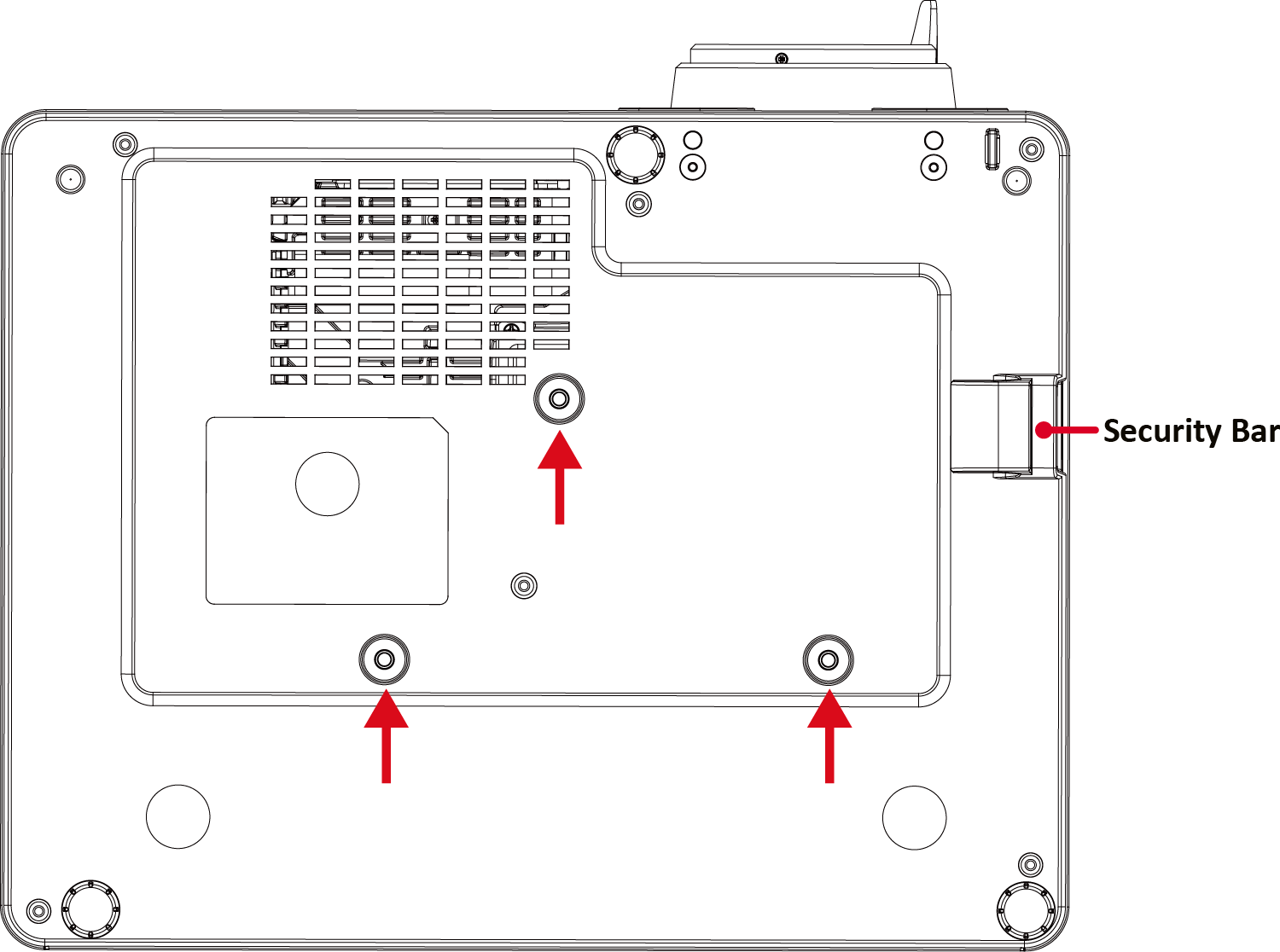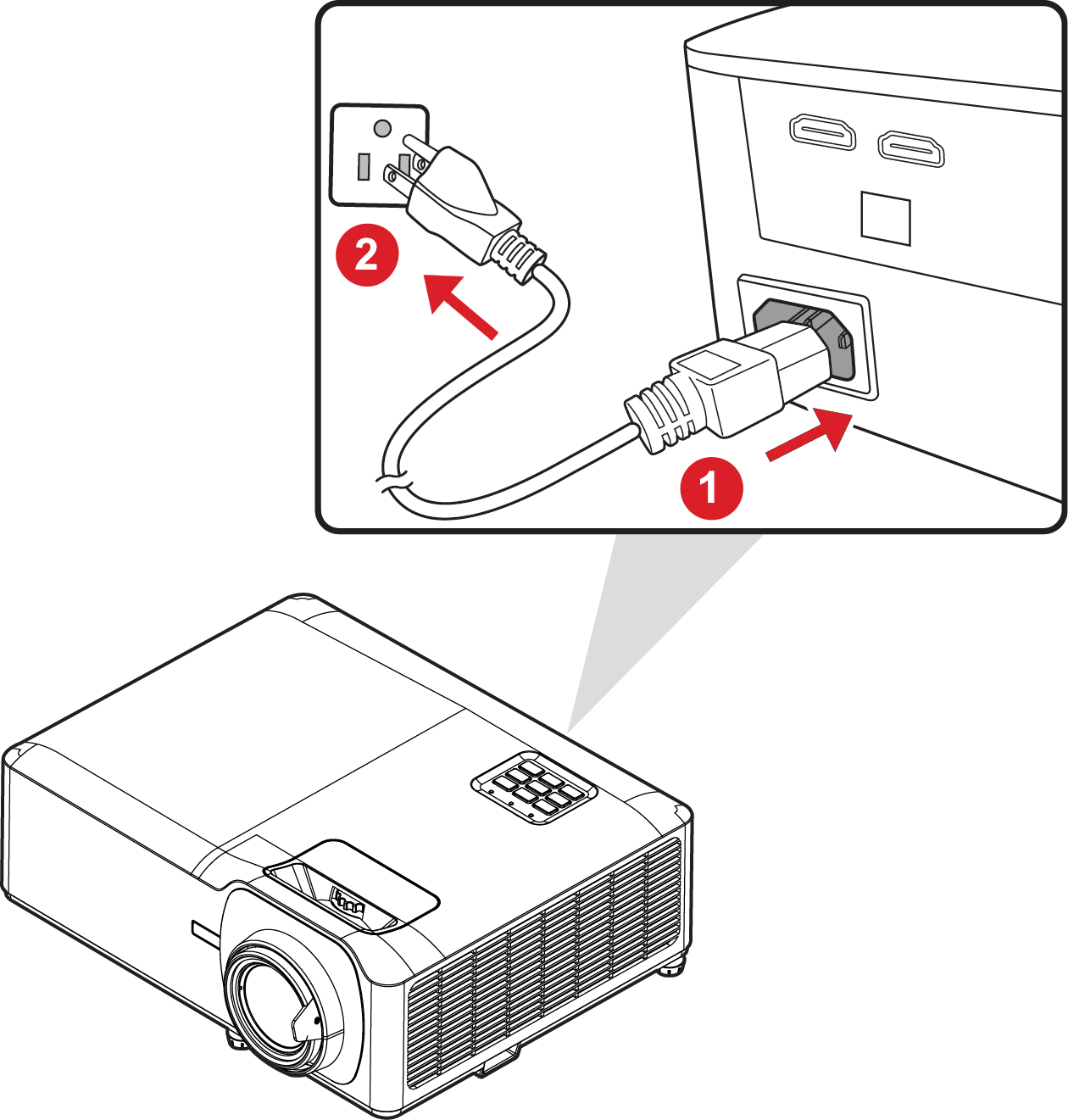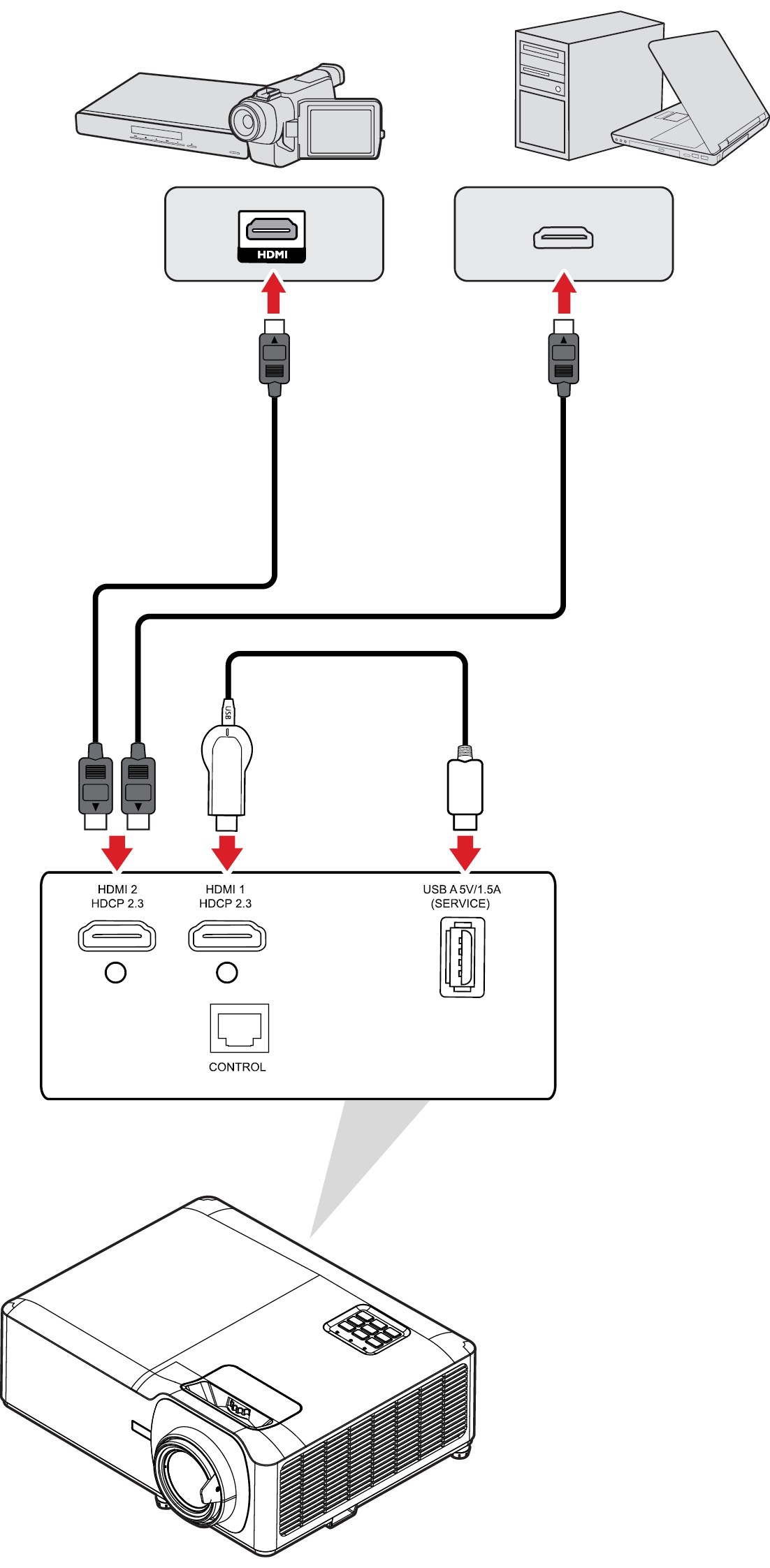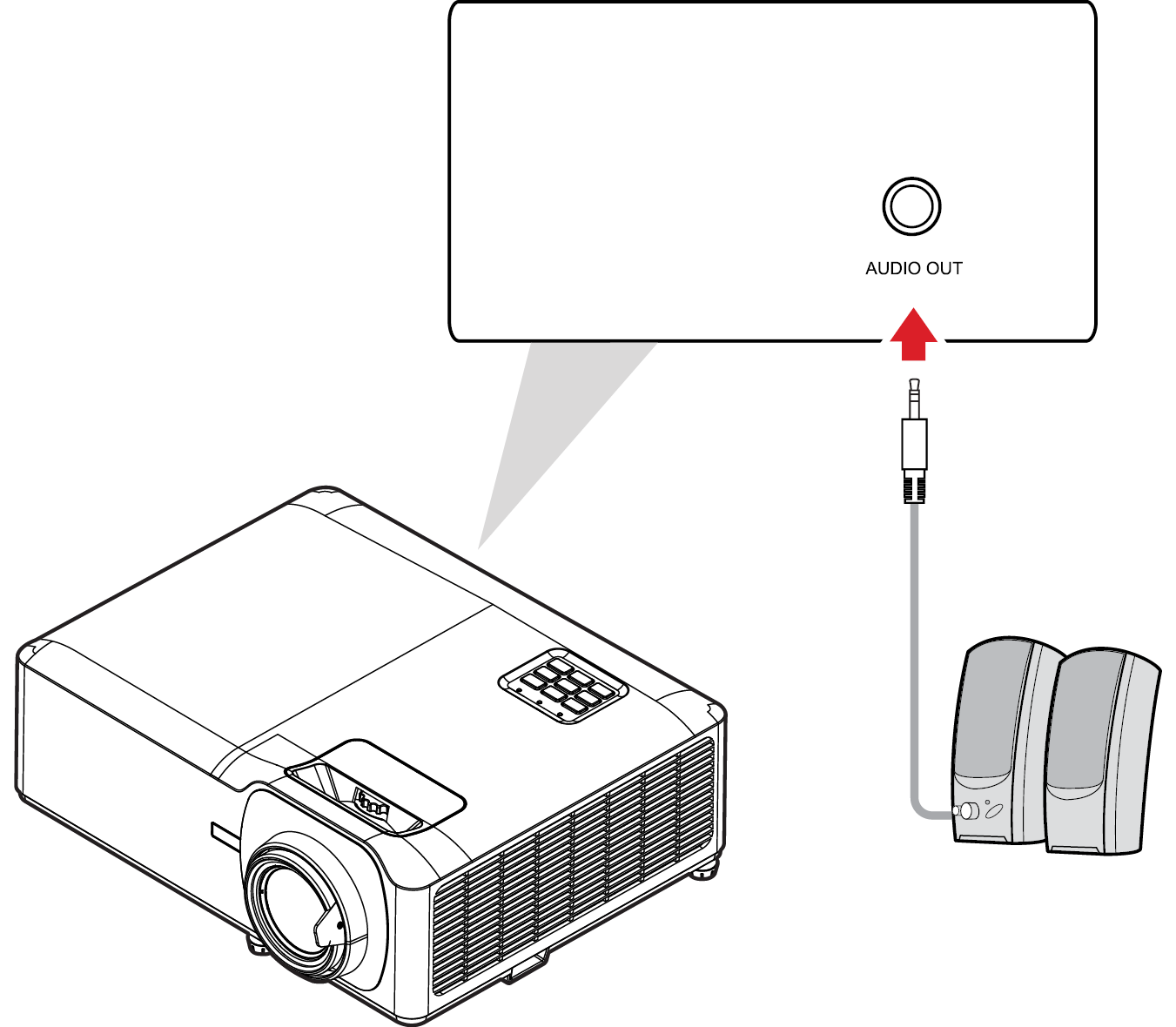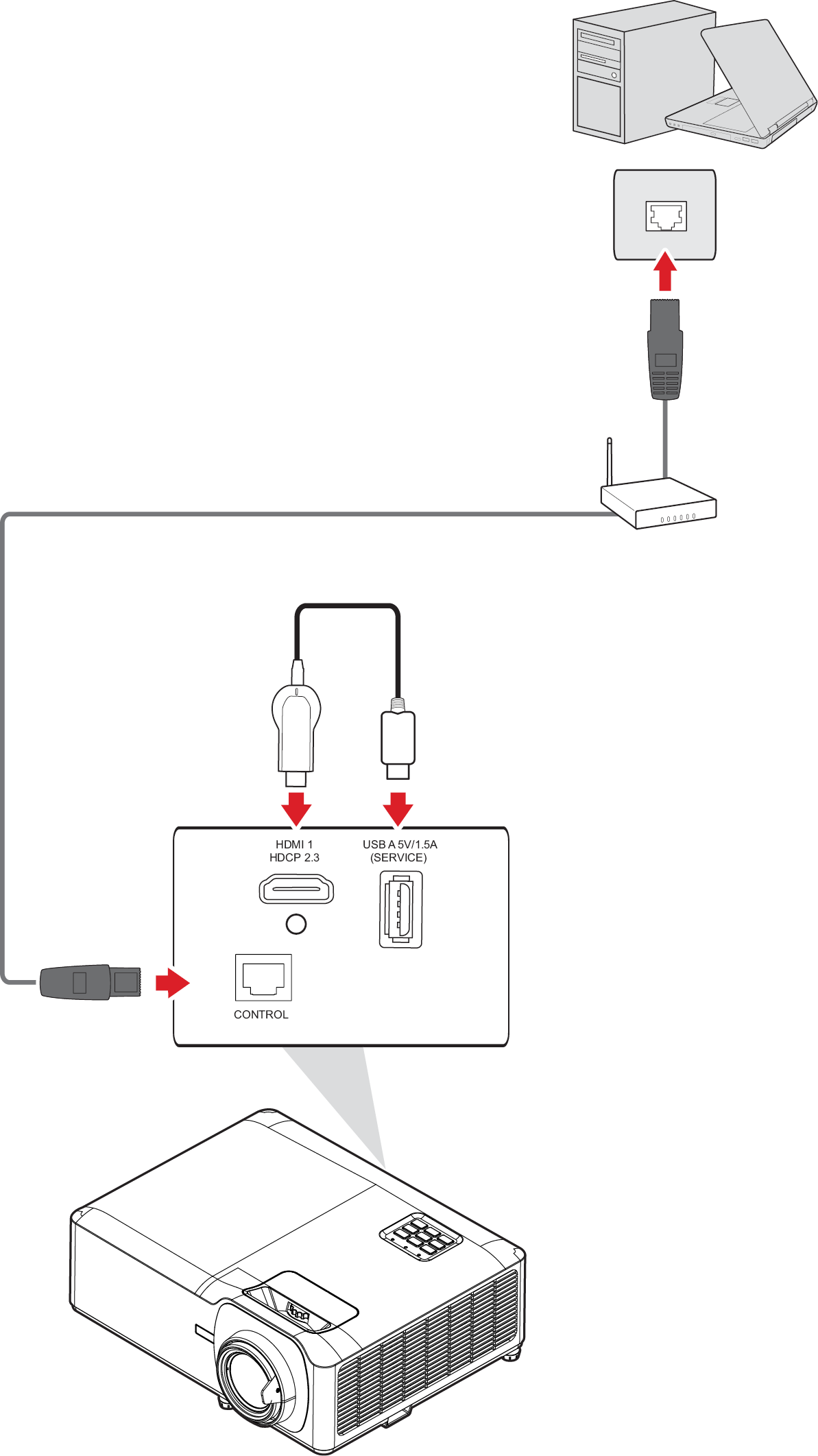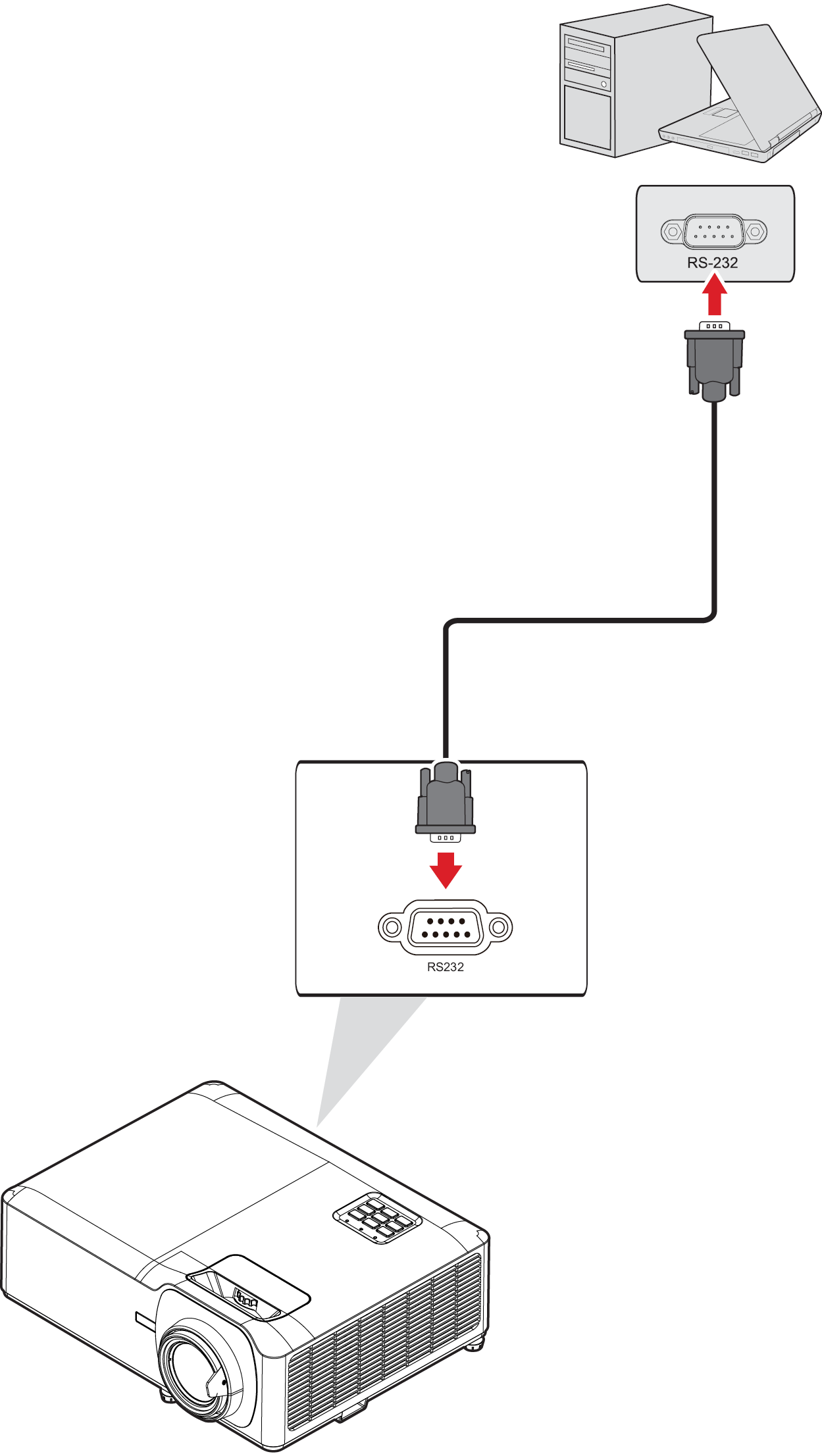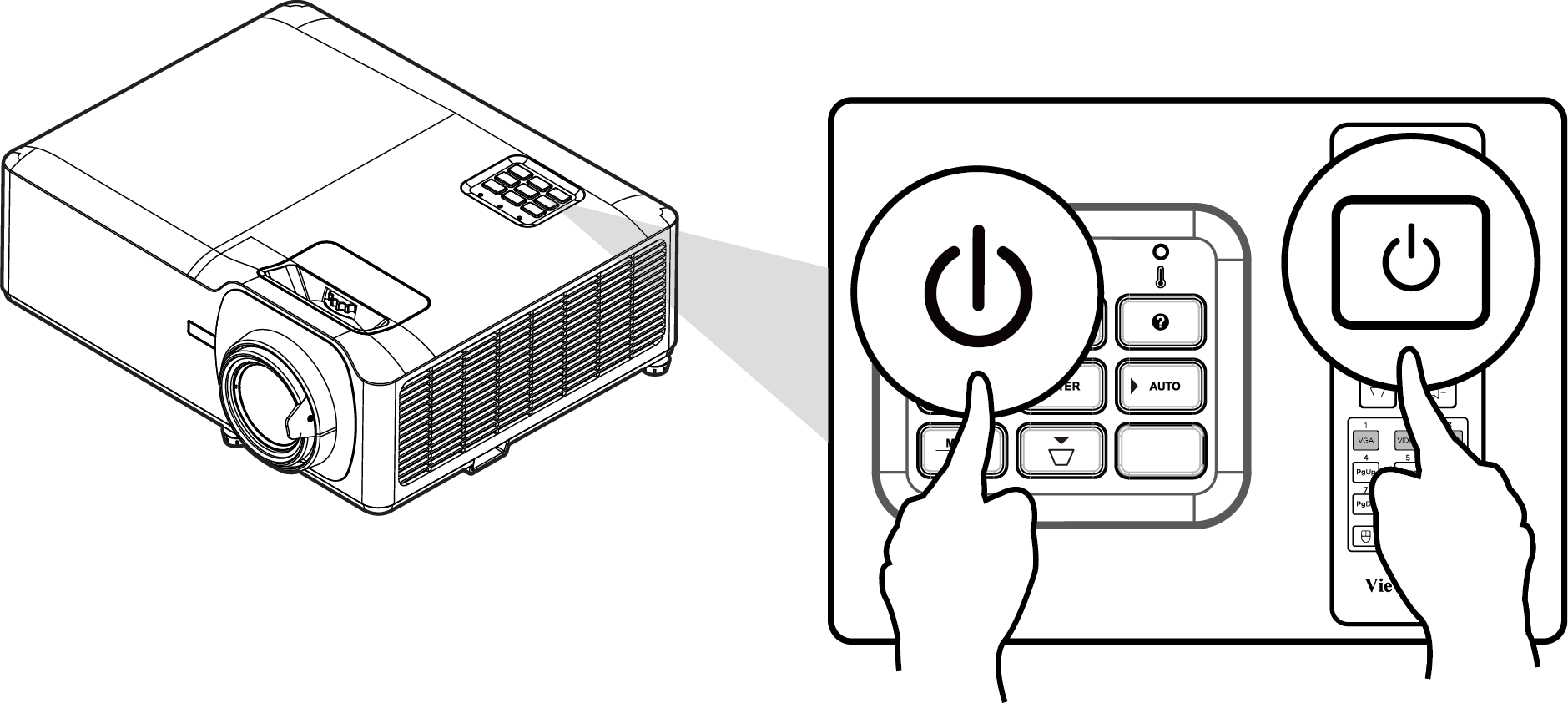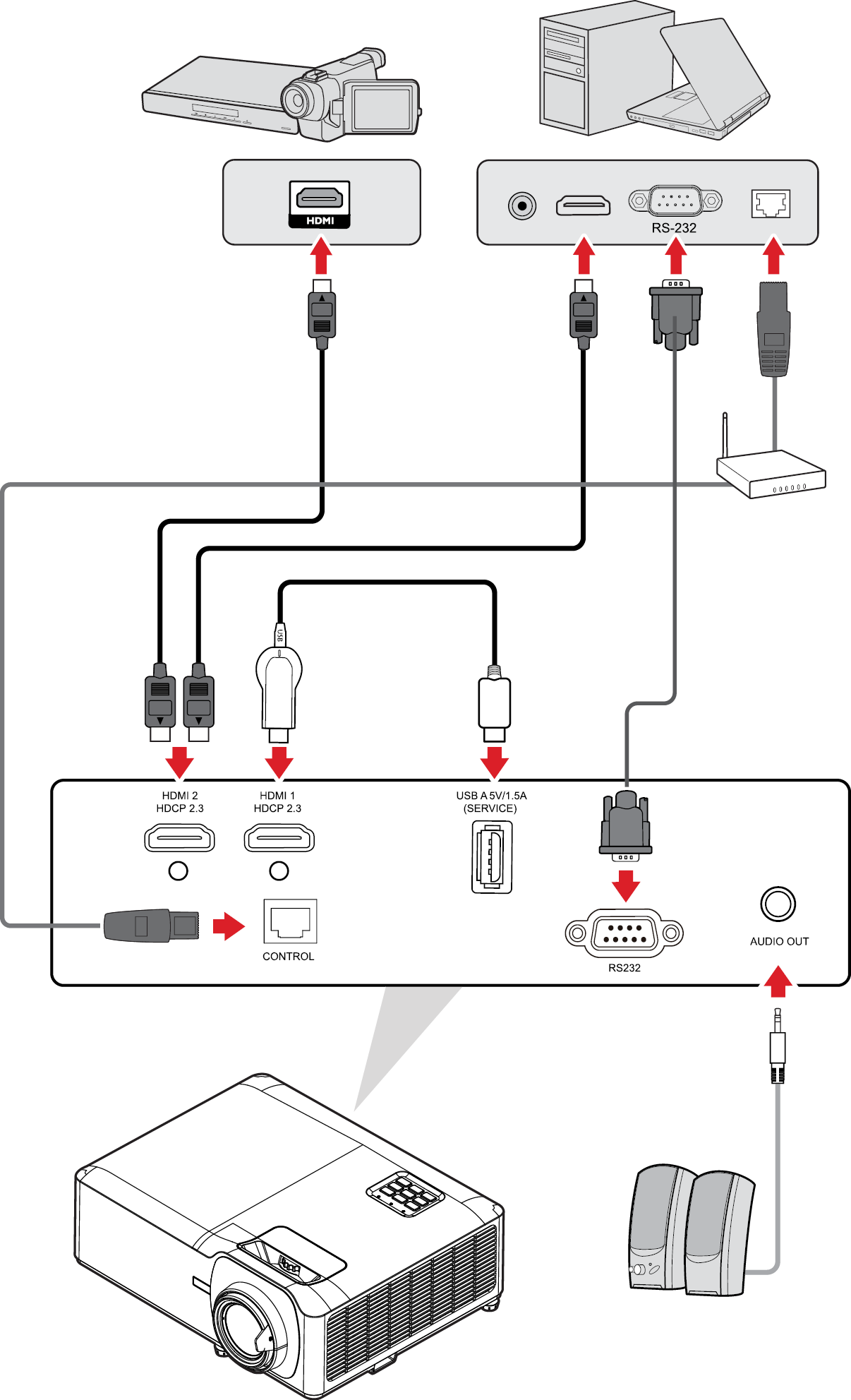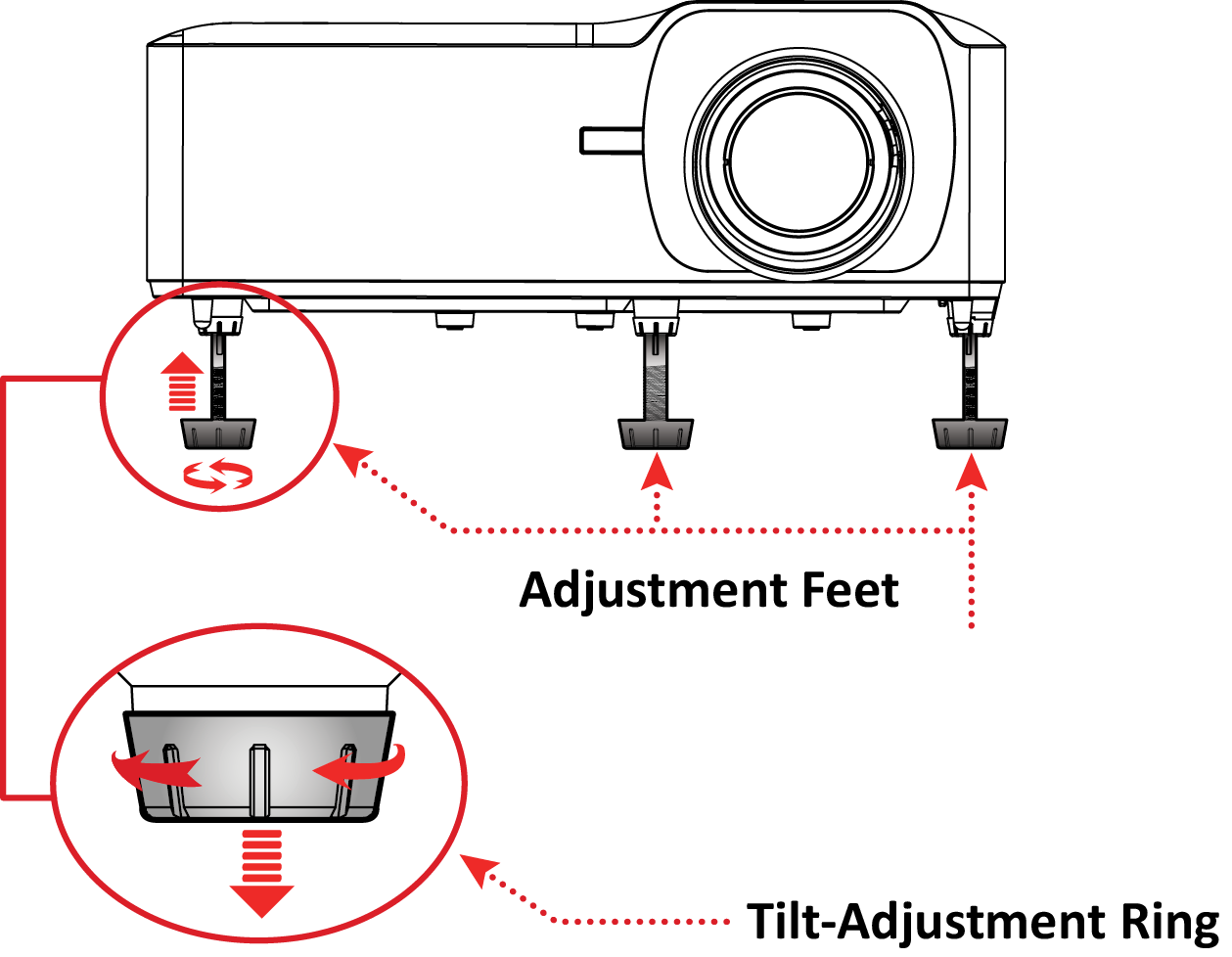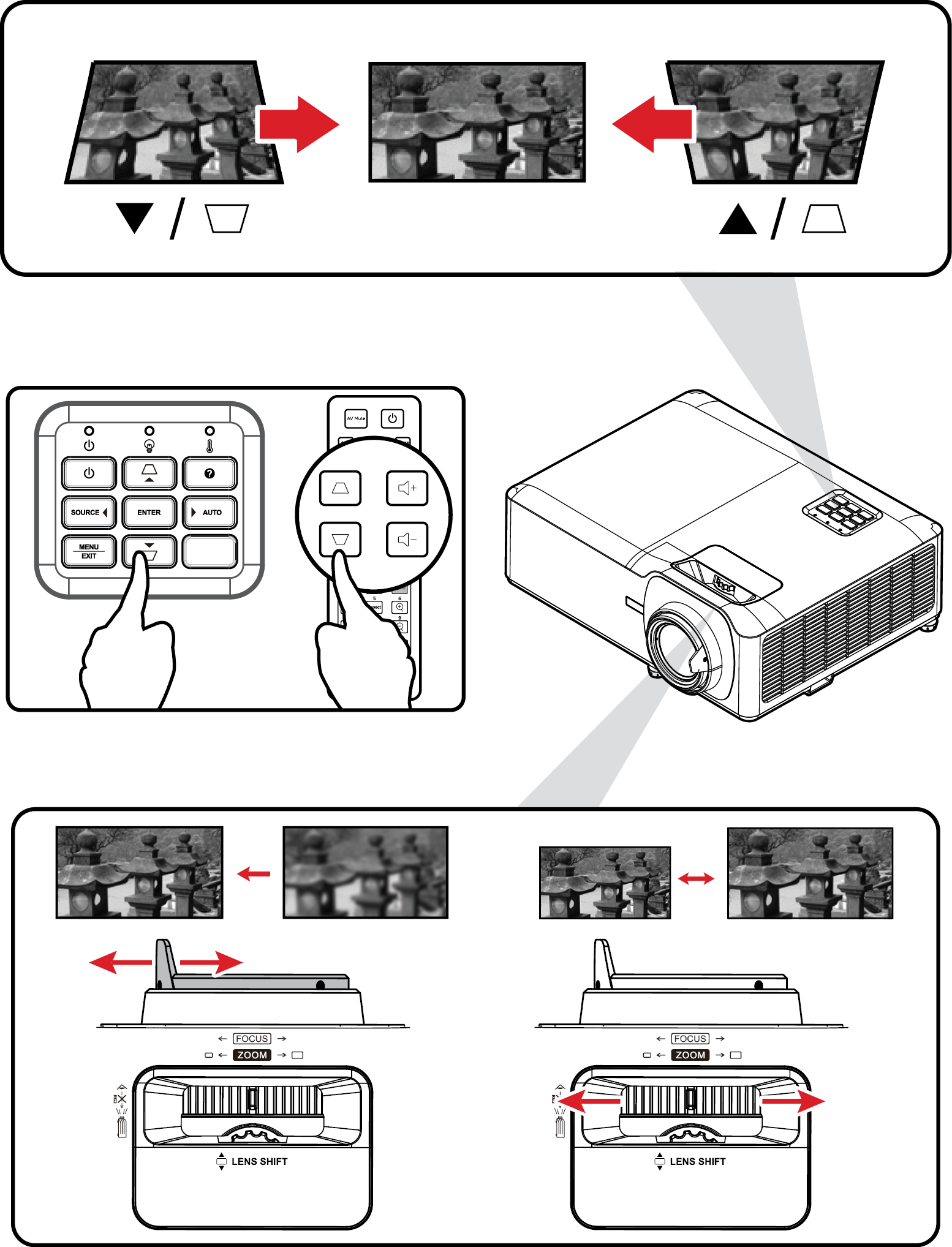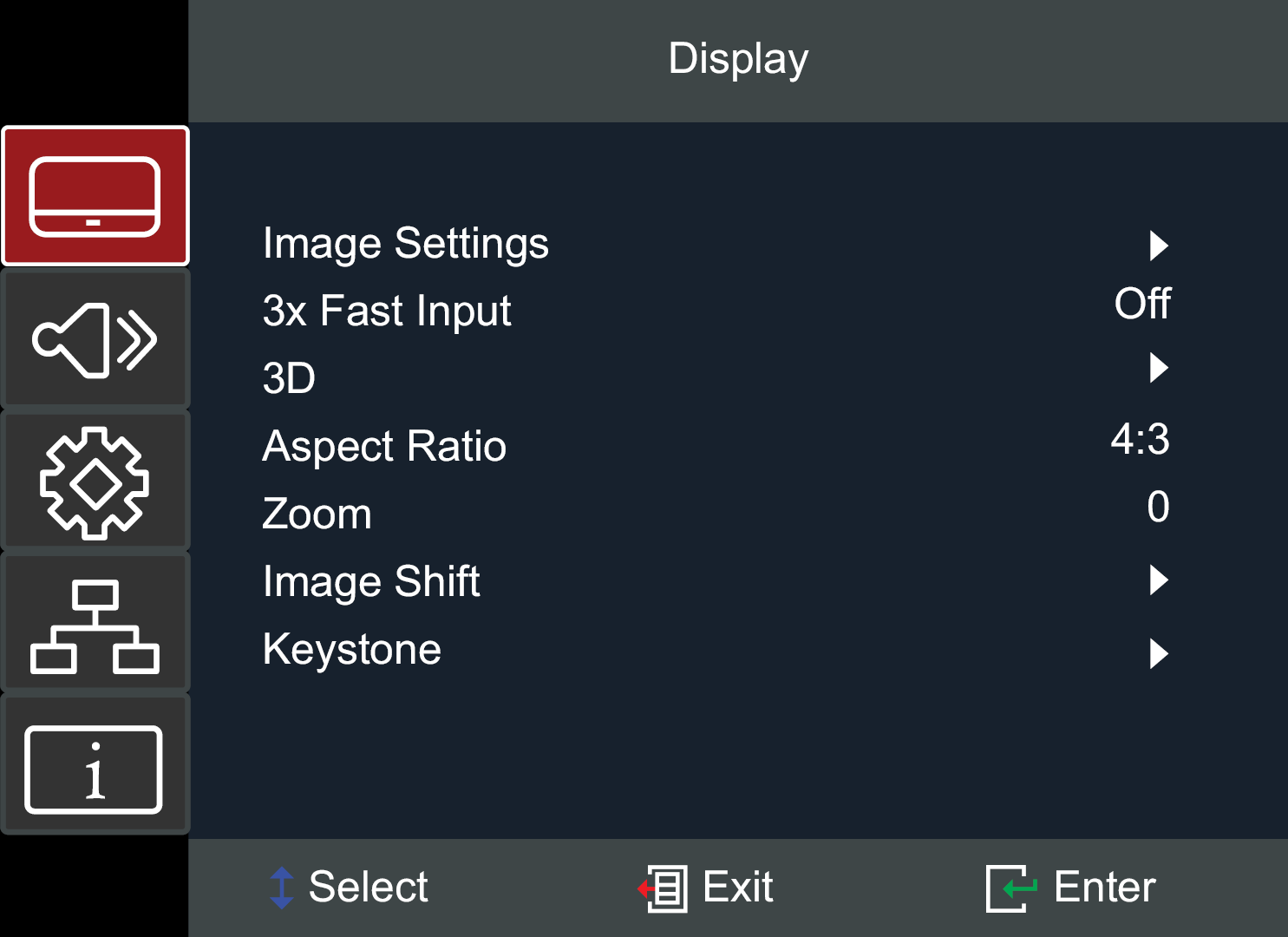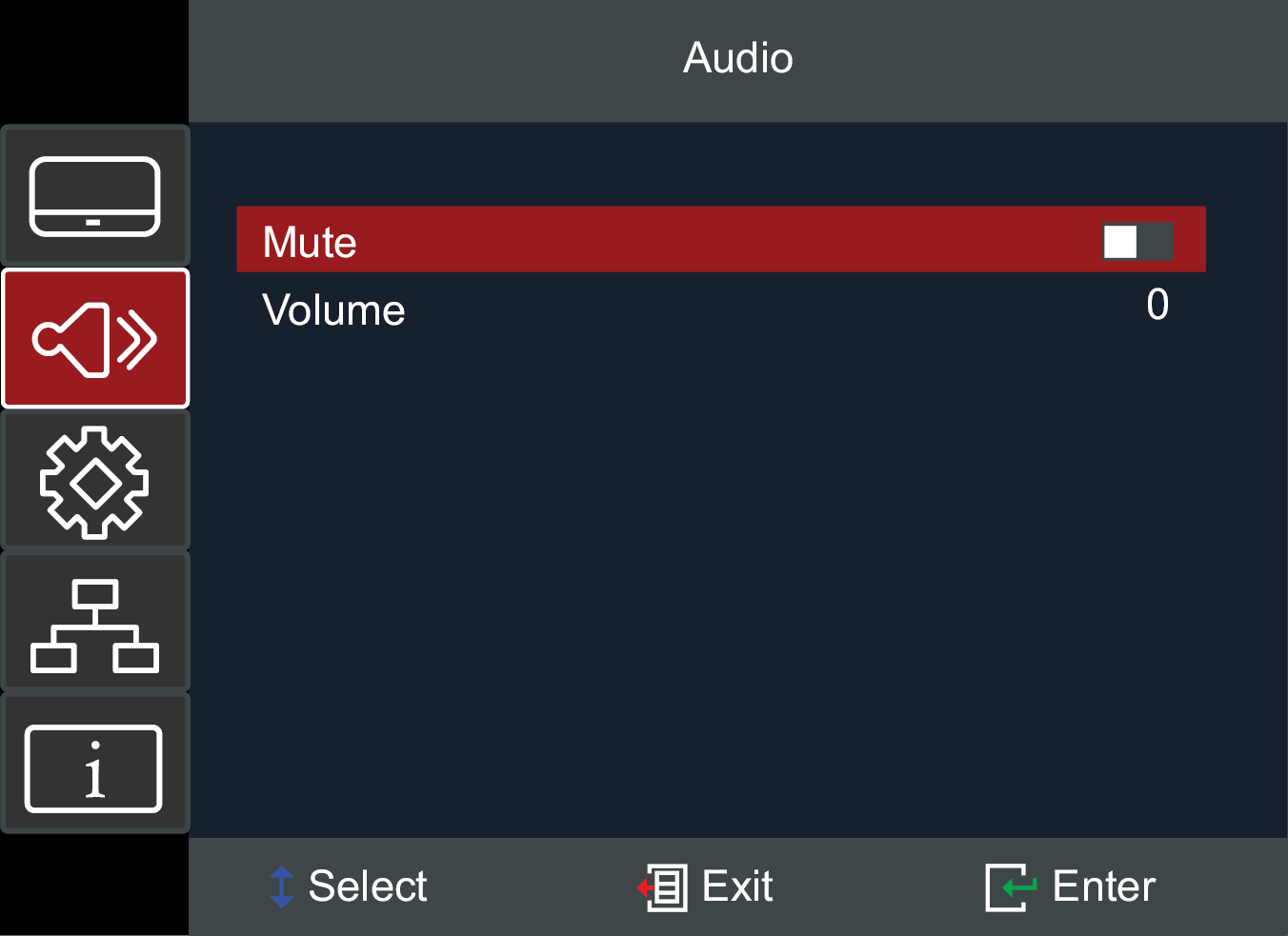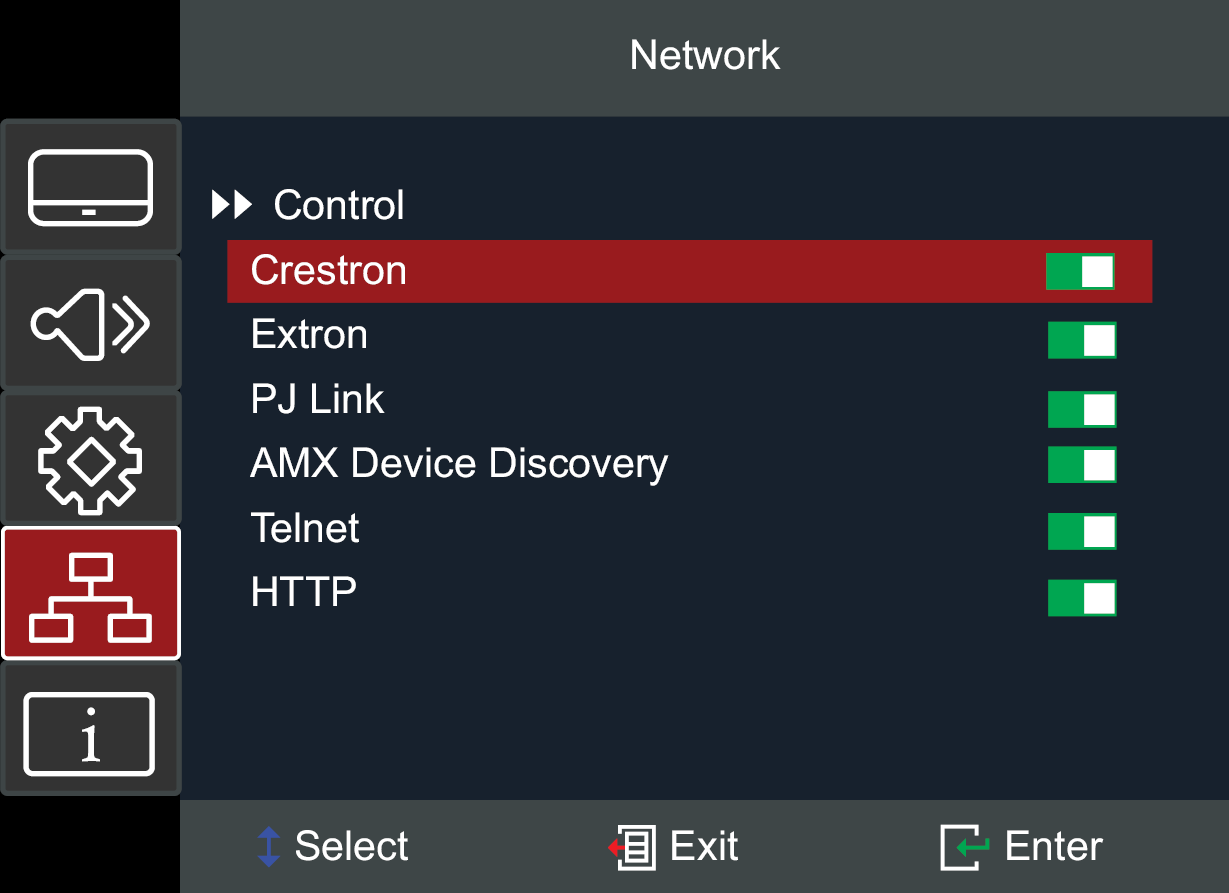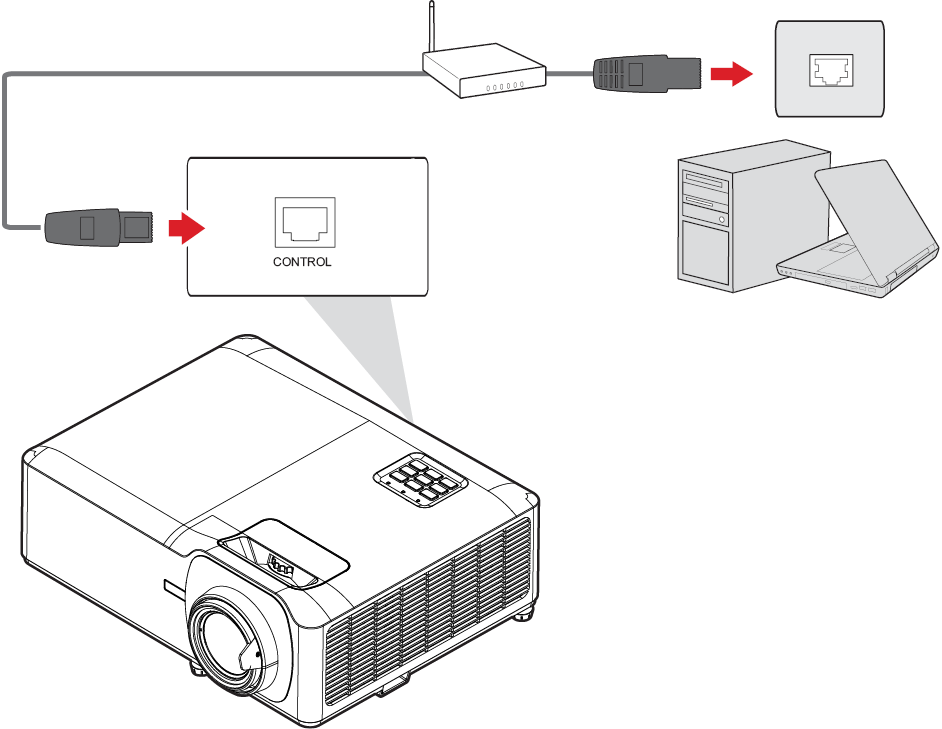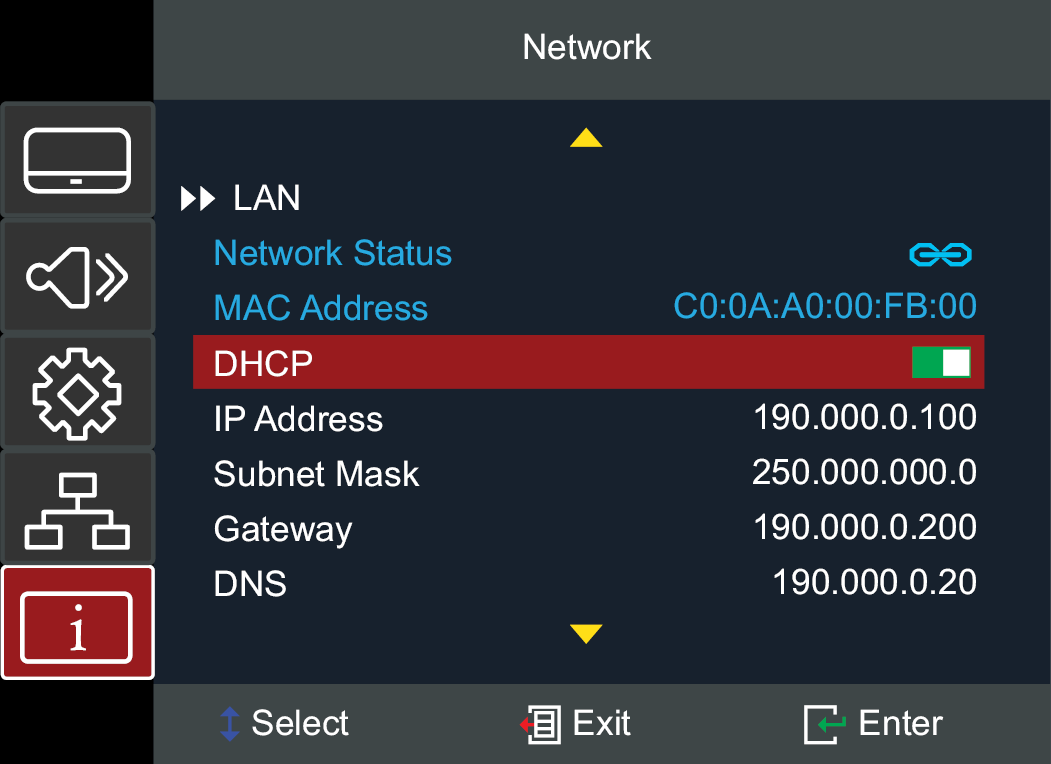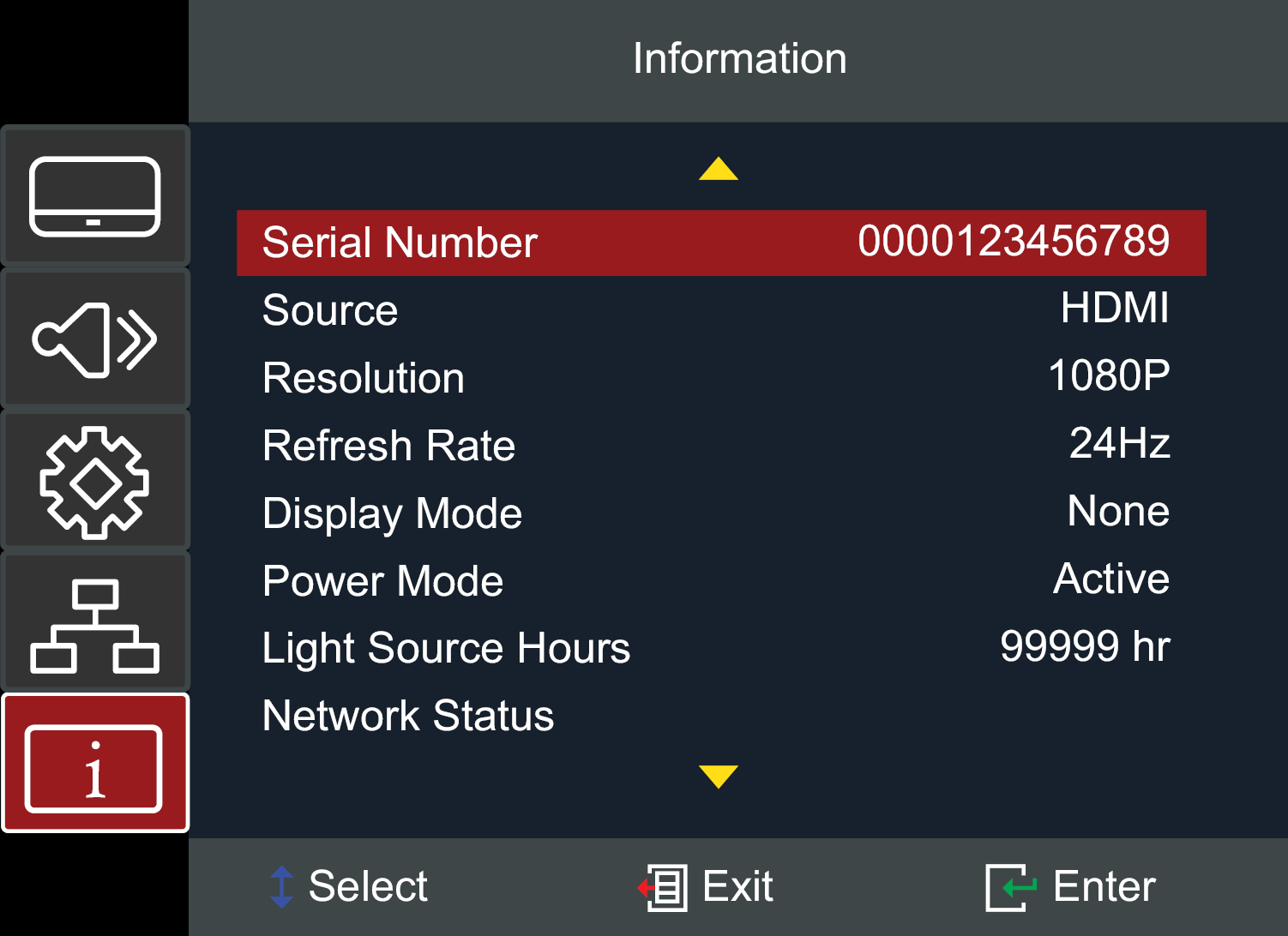LS901HD Full Guide
Introducion
Package Contents
| Number | Description |
|---|---|
| 1 | Projector |
| 2 | Remote Control |
| 3 | Batteries |
| 4 | Quick Start Guide |
| 5 | Power Cord |
- Note: The power cord and remote control included in your package may vary depending on your country. Please contact your local reseller for more information.
Projector Overview
| Number | Description |
|---|---|
| 1 | Remote IR Sensor |
| 2 | Keypad |
| 3 | Lens Shift |
| 4 | Focus Ring |
| 5 | Vent (inlet) |
| 6 | Zoom Ring |
| 7 | Vent (outlet) |
| 8 | Security Bar |
| 9 | Adjuster Foot |
| 10 | Projection Lens |
- Note: Do not block projector intake and exhaust vents.
Keypad
| Icon | Button | Description |
|---|---|---|
| Power | Toggles the projector between standby mode and Power On. | |
| Keystone | Manually corrects distorted images resulting from an angled projection. | |
| Navigation | Selects the desired menu items and makes adjustments when the On-Screen Display (OSD) Menu is activated. | |
| Menu/Exit | Turns on or off the On-Screen Display (OSD) Menu. | |
| Source | Displays the input source selection bar. | |
| Information | Displays the INFORMATION menu. | |
| Enter | Enacts the selected On-Screen Display (OSD) menu item when the OSD Menu is activated. | |
| Auto | Automatically determines the best picture timings for the displayed image. |
Indicator Lights
| Indicator Light | Description |
|---|---|
| Power indicator light | |

|
Light Source indicator light |

|
Temperature indicator light |
I/O Ports
Remote Control
| Button | Description | ||
|---|---|---|---|
| 1 | AV Mute | Hides the screen picture and volume mute. | |
| 2 | Power | Turns the projector On or Off. | |
| 3 | Auto Sync | Automatically determines the best picture timings for the displayed image. | |
| 4 | Source | Displays the input source selection bar. | |
| 5 | Navigation Buttons | Navigates and selects the desired menu items and make adjustments. | |
| 6 | Enter | Confirms the selection. | |
| 7 | Menu/Exit | *Turns the On-Screen Display (OSD) Menu On or Off.
| |
| 8 | Brightness | Displays the brightness mode selection bar. | |
| 9 | Volume Up | Increase the volume level. | |
| 10 | Keystone | Manually correct distorted images. | |
| 11 | Volume Down | Decrease the volume level. | |
| 12 | Video | Unsupported Button | |
| 13 | VGA | Unsupported Button | |
| 14 | HDMI | Selects the HDMI 1 or HDMI 2 input source. | |
| 15 | Aspect | Displays the aspect ratio selection bar. | |
| 16 | Page Up | Unsupported Button | |
| 17 | Zoom In | Increases the projected image size. | |
| 18 | Freeze | Freeze the projected image. | |
| 19 | Zoom Out | Reduces the projected image size. | |
| 20 | Page Down | Unsupported Button | |
| 21 | Display Mode | Displays the color mode selection bar. | |
| 22 | Mouse Mode | Unsupported Button | |
| 23 | Mute | Mute/Unmute. | |
Remote Control - Receiver Range
To ensure proper function of the remote control follow the steps below:
- The remote control must be held at an angle within 30° perpendicular to the projector’s IR remote control sensor(s).
- The distance between the remote control and the sensor(s) should not exceed 8 m (26 ft)
- Note: Refer to the illustration for the location of the infrared (IR) remote control sensor(s).
Replacing the Batteries
- Remove the battery cover from the bottom of the remote control by pressing the finger grip and sliding it across.
- Remove any existing batteries (if necessary) and install two AAA batteries.
- Note: Observe the battery’s polarities as indicated.
- Replace the battery cover by aligning it with the base and pushing it back into position.
- Note: :* Avoid leaving the remote control and batteries in excessive heat or a humid environment.
- Replace only with the same or equivalent type recommended by the battery manufacturer.
- If the battery is drained or if you will not be using the remote control for an extended period of time, remove the battery to avoid damage to the remote control.
- Dispose of used batteries according to the manufacturer’s instructions and local environment regulations for your region.
Initial Setup
Choosing a Location - Projector Orientation
Personal preference and room layout will decide the installation location. Consider the following:
- Size and position of your screen.
- Location of a suitable power outlet.
- Location and distance between the projector and other equipment.
The projector is designed to be installed in one of the following locations:
- Rear[1]
The projector is placed near the floor behind the screen. - Rear Ceiling[1]
The projector is suspended upside-down from the ceiling behind the screen.
Notes:
Projection Dimensions
Mounting the Projector
- Note: If you buy a third party mount, please use the correct screw size. Screw size can vary depending on the thickness of the mounting plate.
- To make sure the most secure installation, please use a ViewSonic® wall or ceiling mount.
- Make sure the screws used to attach the mount to the projector meet the following specifications:
- Screw type: M4 x 10
- Maximum Screw Length: 10 mm
- CAUTION
- Avoid installing the projector near a heat source or air conditioner.
- Keep at least a 10 cm (3.9 in.) gap between the ceiling and the bottom of the projector.
Using the Security Bar
To help prevent the projector from being stolen, use a security slot locking device to secure the projector to a fixed object.
Making Connection
Connecting to Power
# Connect the power cord to the AC IN jack at the rear of the projector.
|
- Note: When installing the projector, incorporate a readily accessible disconnect device in the fixed wiring, or connect the power plug to an easily accessible outlet near the unit. If a fault should occur during operation of the projector, use the disconnect device to switch off the power supply, or disconnect the power plug.
Connecting to External Devices
HDMI Connection
Connect one end of an HDMI cable to the HDMI port of your video device. Then connect the other end of the cable to the HDMI 1 or HDMI 2 port of your projector.
- Note:
- For LS901HD, the HDMI 1 port supports HDCP 2.2; the HDMI 2 port supports HDCP 1.4.
- For LS901-4K, the HDMI 1/ HDMI 2 port supports HDCP 2.3.
Audio Connection
You can connect to various external sound delivery devices via the Audio Out port.
USB and Network Connection
- USB Type-A Connection
- The USB port is for supplying power and service needs.
- Network Connection
- Plug the network cable into the LAN port.
RS-232 Connection
When you use a RS-232 serial port cable to connect the projector to an external computer certain functions can be controlled remotely by the PC, including Power On/Off, Volume adjustment, Input select, Brightness, and more.
Using the Projector
Turning the Projector On
# Make sure the projector’s power cord is properly connected to a power outlet.
|
Selecting an Input Source
The projector can be connected to multiple devices at the same time. However, it can only display one full screen at a time.
When Auto Source is on, the projector will automatically search for input sources. If multiple sources are connected, press the Source button on the projector or remote control to select the desired input.
- Note: Make sure the connected sources are also turned on.
Adjusting the Projected Image
Adjusting the Projector’s Height and Projection Angle
The projector is equipped with three adjustment feet. Adjusting the feet will change the projector’s height and the vertical projection angle.
Adjusting the Focus, Keystone, and Lens Shift
You can improve and adjust the clarity and position of the image by adjusting the Focus Ring, Keystone Keys, Lens Shift dial, or Zoom Ring.
Turning the Projector Off
- Press the Power button on the projector or remote control and a “power off message” will appear.
- Press the Power button again to confirm and shut down the projector.
- The Power Indicator Light will turn solid red and enter standby mode.
Menu Operation
On-Screen Display (OSD) Menu
The projector has multilingual on-screen display menus that allow you to make image adjustments and change a variety of settings.
| Menu | Description | |
|---|---|---|
| Display | Adjust Image, 3D, Aspect Ratio, Edge Mask, Zoom, Image Shift, and Keystone settings. | |
| Audio | Adjust the volume level or mute. | |
| Setup | Adjust Projection, Power, Security, Language, Menu, Input Source, etc. settings. | |
| Network | Adjust LAN and RS-232 control settings. | |
| Information | View projector and network information. | |
The projector has multilingual on-screen display menus that allow for image and settings adjustment.
- To open the On-Screen Display (OSD) Menu, press the Menu/Exit button on the projector or the remote control.
- When the OSD is displayed, use the Navigation ▲ / ▼ buttons to select any item in the main menu. While making a selection on a particular page, press the Enter button on the projector or the remote control to enter a sub-menu.
- Use the Navigation ▲ / ▼ / ◀ / ▶ buttons to select the desired item in the sub-menu and then press Enter to view further settings. Adjust the settings by using the Navigation ▲ / ▼ / ◀ / ▶ buttons.
- Select the next item to be adjusted in the sub-menu and adjust as described above.
- Press Enter to confirm, and the screen will return to the main menu.
- To exit, press the Menu/Exit button again. The OSD menu will close and the projector will automatically save the new settings.
On-Screen Display (OSD) Menu Tree
Menu Options
Display Menu
| Menu | Description | |
|---|---|---|
| Image Setting | Color Mode
There are several predefined display modes that you can choose from to suit your viewing preference. |
Presentation
|
Brightest
| ||
HDR SIM.[1]/HDR[2]
| ||
HLG[2]
| ||
Movie
| ||
Gamma
| ||
sRGB
| ||
DICOM SIM.[1]
| ||
Golf
| ||
3D[3]
| ||
Brightness
| ||
Contrast
| ||
Sharpness
| ||
Color
| ||
Tint
| ||
Gamma
| ||
| Color Settings | Brilliant Color™
| |
Color Temperature
| ||
Color Management
| ||
RGB Gain/Bias[1]
| ||
Color Space
| ||
| Light Source Mode | Dynamic Black
| |
Eco
| ||
Light Source Power
| ||
| 3x Fast Input[1]/Ultra Fast Input[2] | This function is favorable to frame rate reducing. | |
| 3D[4] | 3D Mode
Enable or disable the 3D function. | |
| 3D Format[5]
Select the 3D content format. |
Auto
| |
SBS
| ||
Top and Bottom
| ||
Frame Sequential
| ||
| Aspect Ratio | Select the aspect ratio of the projected image. | 4:3
|
16:9
| ||
21:9[2]
| ||
Native
| ||
Auto
| ||
| Zoom | Reduce or magnify the projected image | |
| Image Shift | Adjust the projected image horizontally or vertically. | |
| Keystone | Four Corners[6]
| |
H.Keystone
| ||
V. Keystone
| ||
3 x 3 Warp[2]
| ||
Reset
| ||
Notes:
- ↑ 1.0 1.1 1.2 1.3 LS901HD only.
- ↑ 2.0 2.1 2.2 2.3 2.4 LS901-4K only.
- ↑ 3D glasses are needed.
- ↑ This projector is a 3D ready projector with DLP-Link 3D solution. Please make sure your 3D glasses are for DLP-Link 3D. This projector supports Blue-ray 3D and frame sequential (page-flip) 3D via the HDMI 1/HDMI 2 ports. For the best performance, 1920 x 1080 resolution is recommended. Please note that 4K (3840 x 2160) resolution is not supported in 3D mode.
- ↑ A Blu-ray 3D source will be detected automatically, and options will not be selectable.
- ↑ While adjusting the Four Corners, the Aspect Ratio, Edge Mask, Image Shift, and Zoom menus will be disabled. To enable them, reset the Keystone settings to default
Audio Menu
| Menu | Description |
|---|---|
| Mute | Temporarily turn off the sound. |
| Volume | Adjust the volume level. |
Setup Menu
| Menu | Description | |
|---|---|---|
| Projection | Select the preferred projection: Front, Rear, Ceiling-Top, and Rear-Top. | |
| Power Settings | Direct Power On
| |
Signal Power On
| ||
Auto Power Off (min.)[1][2]
| ||
| Power Mode (Standby)[3][4][1][2] | Eco
| |
Active
| ||
ErP Off
| ||
| Security | Power On Lock[5]
| |
Change Password
| ||
| HDMI CEC[6][7][8] | When you connect HDMI CEC-compatible devices to the projector with HDMI cables, you can control them on the same power on or power off status using the HDMI CEC control feature in the projector’s OSD. This lets one device or multiple devices in a group power on or power off via HDMI CEC in a typical configuration. | |
| Test Pattern | Select the test pattern from green grid, magenta grid, white grid, white, or disable this function (off). | |
| Options | Language
| |
Auto Source
| ||
High Altitude
| ||
Logo
| ||
| Reset[9] | Return the settings to default. | |
Notes:
- ↑ 1.0 1.1 When you deactivate the power management function, energy consumption will increase.
- ↑ 2.0 2.1 A warning message will also appear:

- ↑ There is no USB power supply when the projector is in standby mode.
- ↑ If you wish to connect to the projector via LAN in its standby mode, be sure you have selected “Erp Off”
- ↑ : The default password is: 1234
- ↑ In order for the CEC function to work properly, make sure that the device is correctly connected to the HDMI input of the projector via an HDMI cable, and its CEC function is turned on.
- ↑ Depending on the connected device, the CEC function may not work.
- ↑ LS901-4K ONLY: If both HDMI 1 and HDMI 2 ports are occpied, the CEC funcntion will not be able to detect the correct source.
- ↑ When resetting, the following settings will still remain: Zoom, Keystone Settings, Language, Projection, Power Mode (Standby), High Altitude Mode, Security Settings, Network Settings, Light Source Hours Information.
Network Menu
| Menu | Description |
|---|---|
| LAN | View network information and enable/disable DHCP. |
| Control[1] | Enable or disable network control suites. |
Notes:
- ↑ To connect successfully, the control suite must be enabled.
Controlling the Projector throught a Network
The projector provides diverse networking and remote management features. The LAN /RJ45 function of the projector, through a network, can remotely manage: Power On/Off, Volume adjustment, Input select, Brightness, and more.
- Note: Please ensure Network > Control > HTTP is enabled.
- Connect the projector to a network via the LAN/RJ45 port.
- Open the On-Screen Display Menu and go to: Network > LAN.
- Select DHCP and turn it On to obtain an IP address automatically; or select Off to enter the network information manually.
- Note: Please wait for around 15~20 seconds, then re-enter the LAN settings page. The Projector IP Address, Subnet Mask, Default Gateway, DNS Server settings will be displayed. Make note of the IP address displayed in the Projector IP Address row.
- Using a web browser, and under the same network, type in the projector’s IP address.
- Enter the user name and password, then click Log in.
- Note: When logging in for the first time, please follow the description on the web page to set a password. Then you will be able to log in.
Information Menu
View Serial Number, Source, Resolution, Refresh Rate, Display Mode, Power Mode, Light Source Hours, Network Status, IP Address, Brightness Mode, and Firmware Version information.


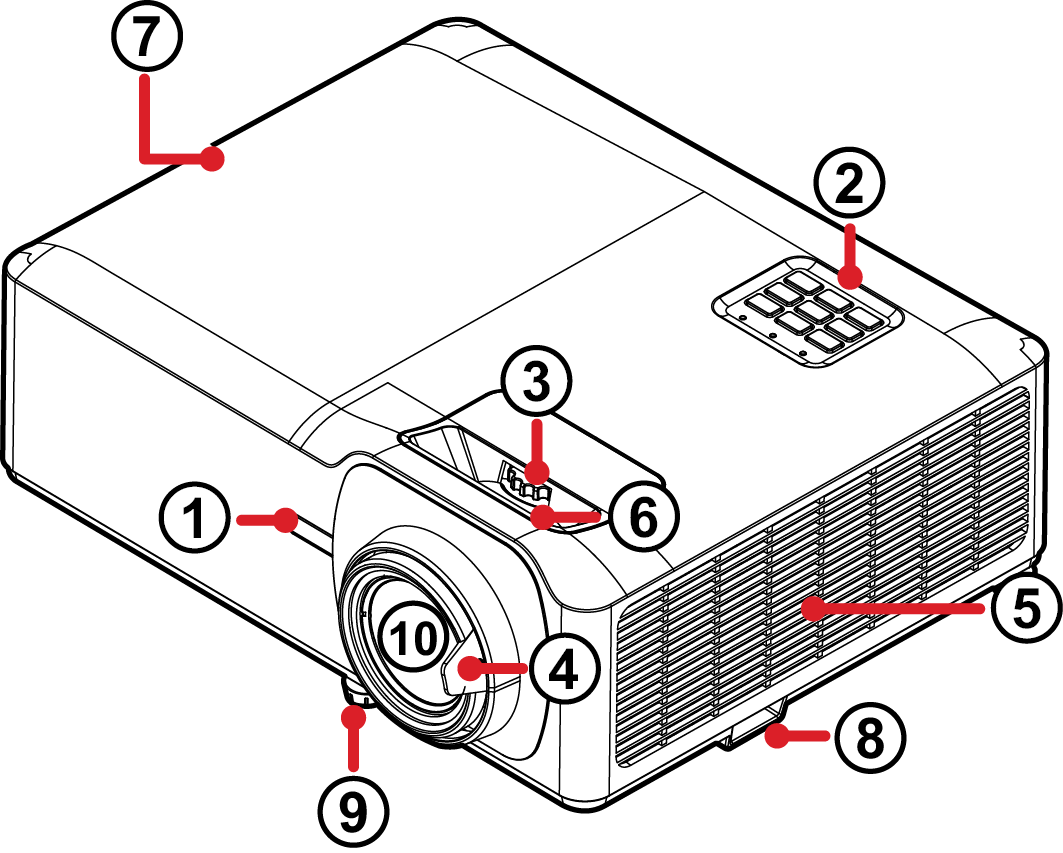
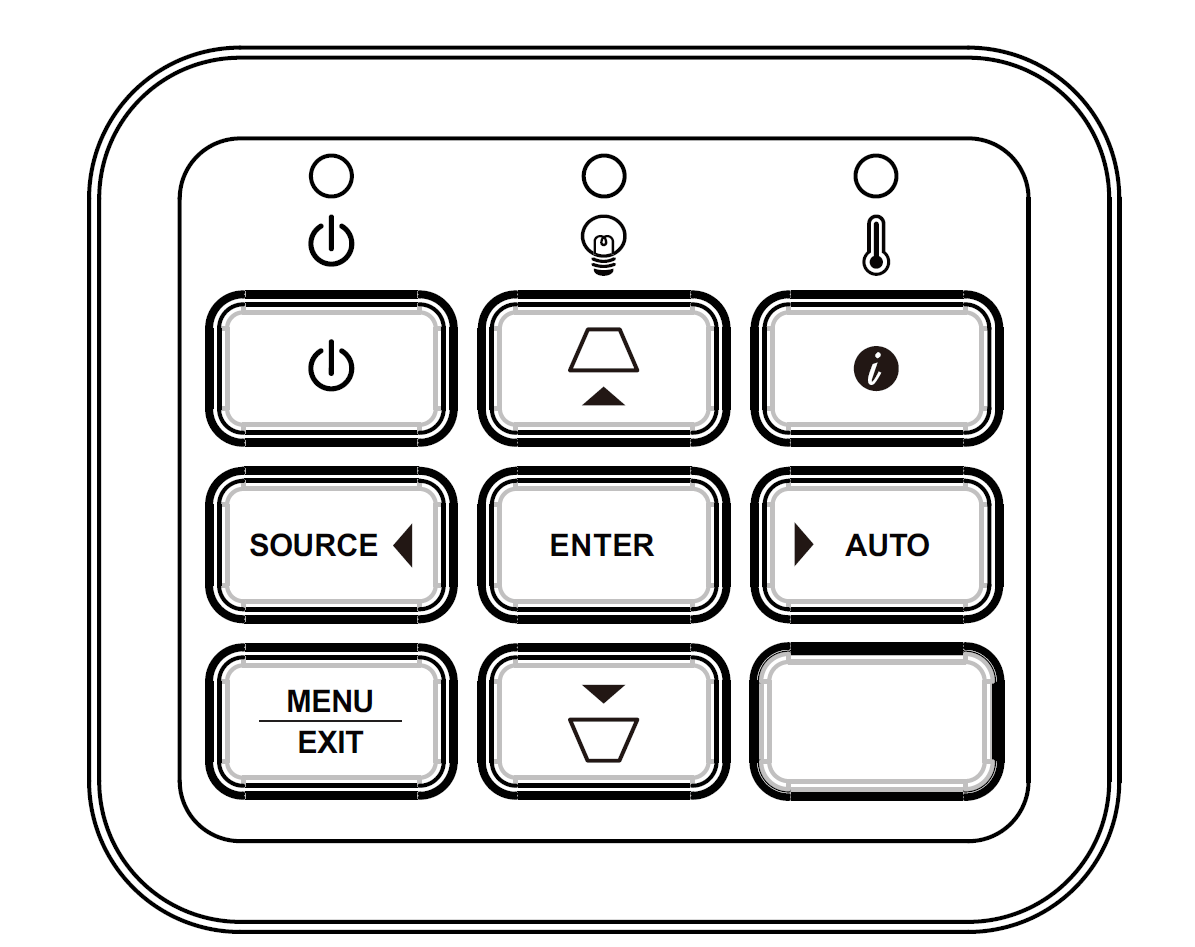
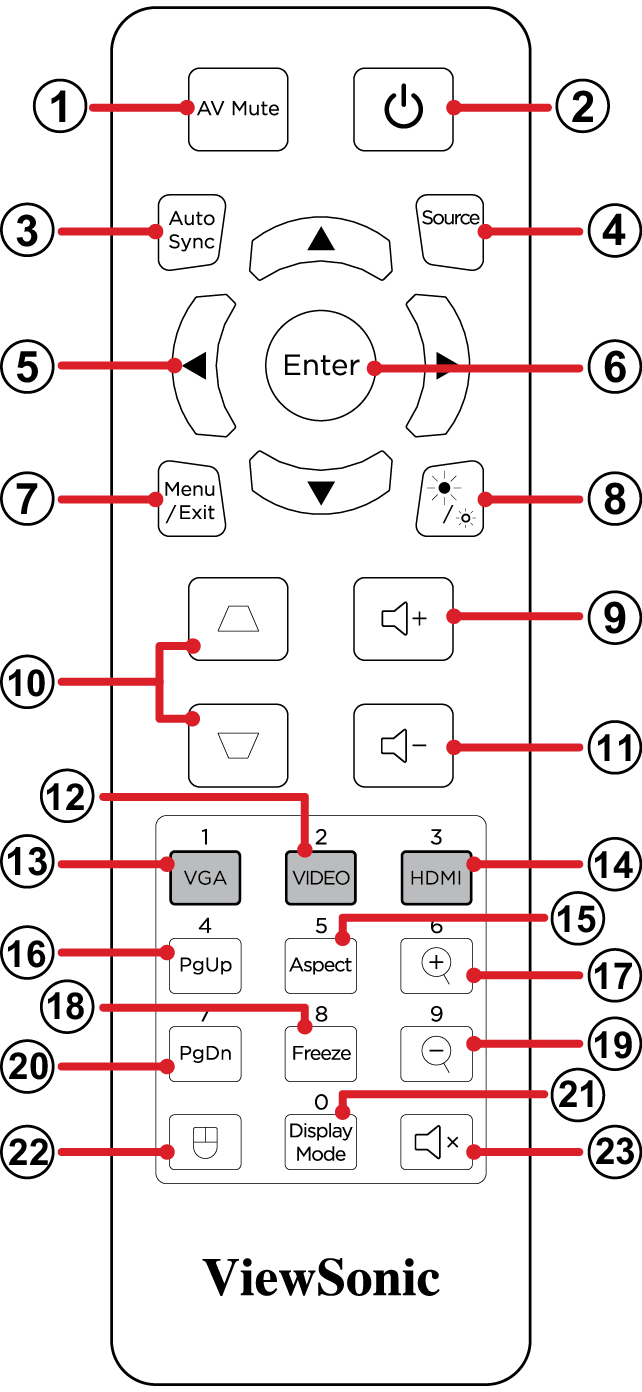
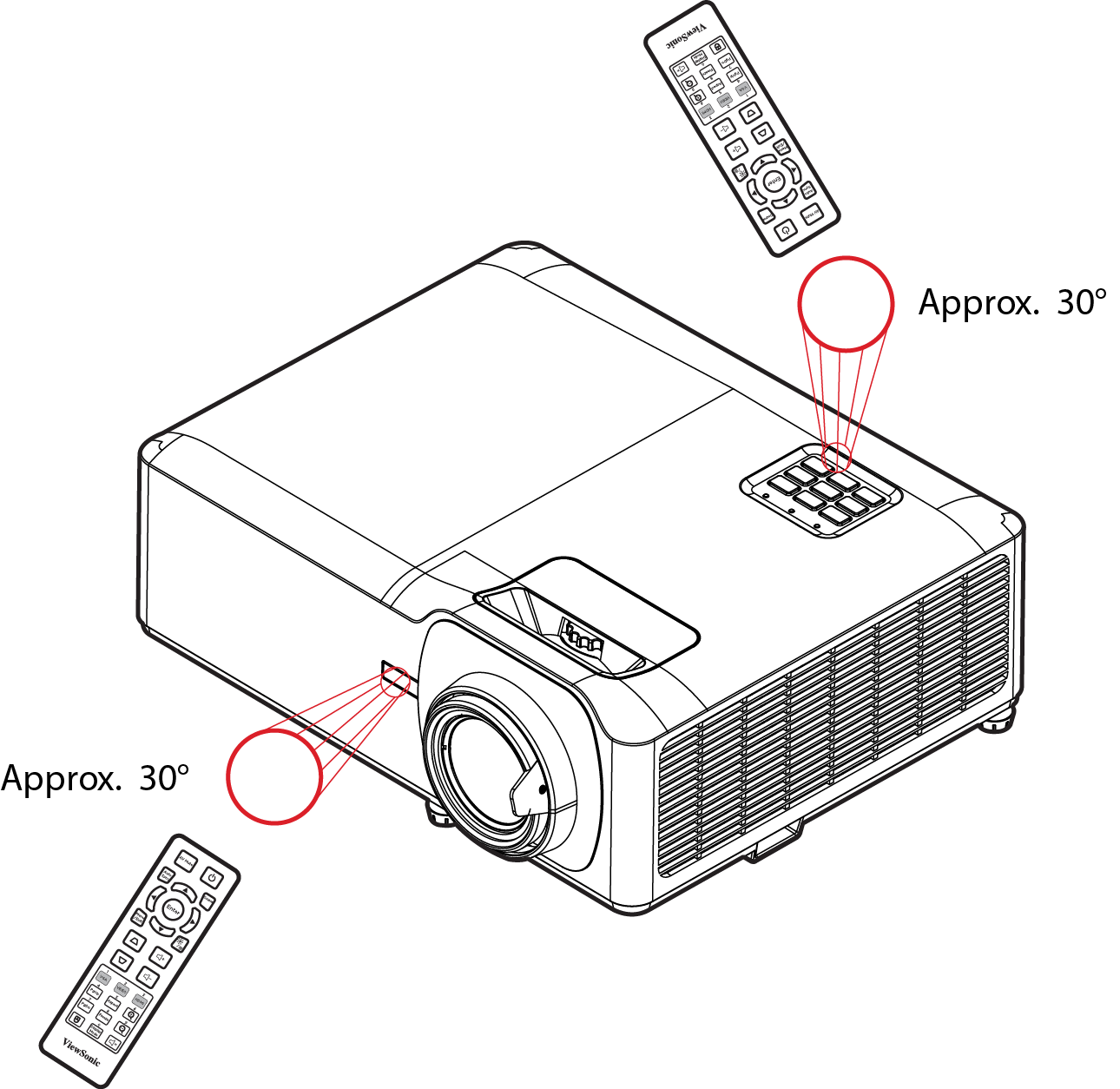


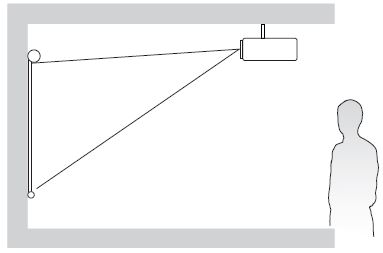
![Rear[1] The projector is placed near the floor behind the screen.](/images/5/5d/LS710HD_LS751HD_Rear_Table.JPG)
![Rear Ceiling[1] The projector is suspended upside-down from the ceiling behind the screen.](/images/2/22/LS710HD_LS751HD_Rear_Top.JPG)
